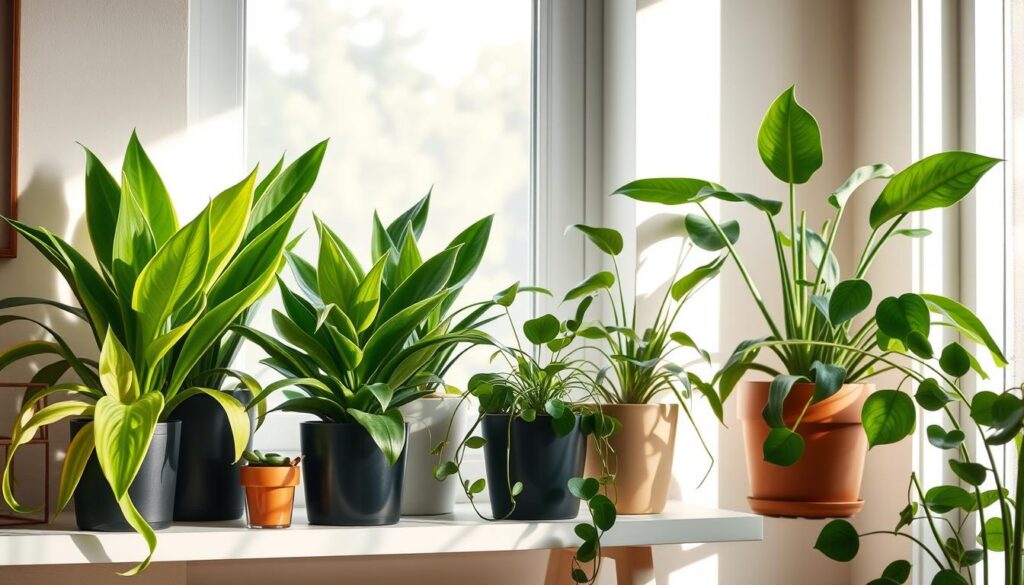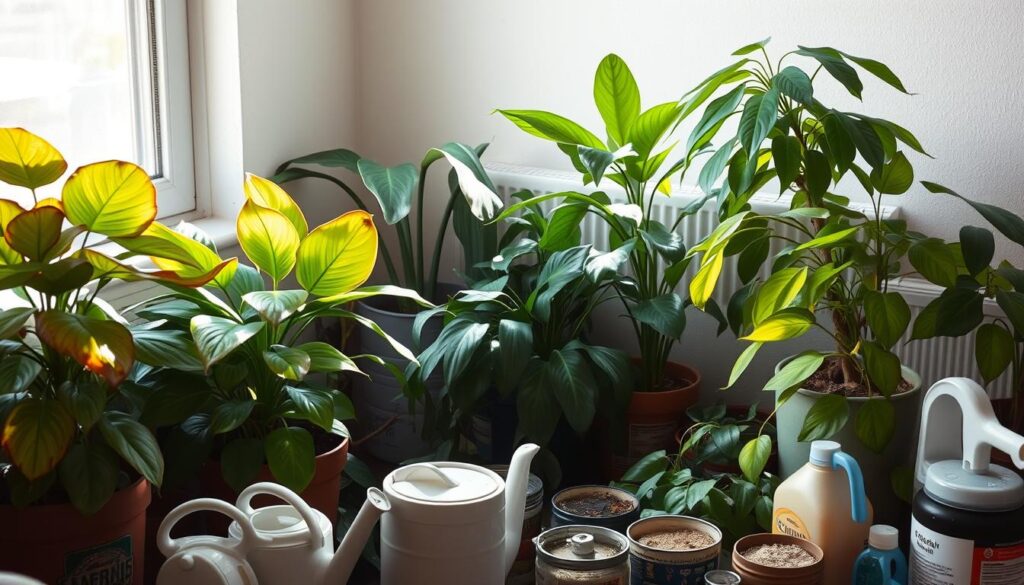Did you know that nearly 90% of indoor plants do best with the right sunlight? Knowing what light your plants need is key for their health and growth. Without enough light, even the toughest plants can struggle, leaving you disappointed.
In this guide, we’ll explore why light is so important for indoor plants. We’ll also look at how both natural and artificial light can affect your plants’ health.
Key Takeaways
- Understanding sunlight is essential for healthy indoor plants.
- Different types of light conditions affect plant growth uniquely.
- Natural and artificial lighting both play vital roles in indoor plant care.
- Proper plant placement can maximize sunlight exposure.
- Every room’s lighting situation varies and should be assessed.
- Seasonal changes impact light availability and plant needs.
Understanding Sunlight and Plants
Sunlight is key to keeping indoor plants healthy. It’s not just energy; it’s vital for plant growth indoors. Plants need light to grow, look vibrant, and stay strong. Knowing how sunlight affects plants helps you light them right.
Why Sunlight is Crucial for Indoor Plants
Sunlight is super important for indoor plants. Without enough, they grow slow, look dull, and can’t thrive. Sunlight helps plants make food through photosynthesis, which is crucial for their health.
The Science of Photosynthesis
Photosynthesis lets plants use sunlight to make food. Chlorophyll, the green stuff in plants, grabs light energy. This energy turns carbon dioxide and water into glucose and oxygen. Knowing this shows why plants need the right amount of light.
| Photosynthesis Process | Components | Outcome |
|---|---|---|
| Light Absorption | Chlorophyll | Capture of light energy |
| Energy Conversion | Sunlight, Carbon Dioxide, Water | Production of Glucose and Oxygen |
| Growth Support | Photosynthesis | Growth and Health of Plants |
Types of Light Conditions for Indoor Plants
Knowing the different light conditions is key for indoor gardening success. Plants need various light levels to grow well. They can be grouped into direct sunlight, indirect sunlight, and low light. This knowledge helps plants thrive in their homes.
Direct Sunlight: What Does It Mean?
Direct sunlight means light from the sun without any blockage. It’s best for direct sunlight plants that love bright, unfiltered light. These plants need at least six hours of direct sunlight a day to stay healthy and vibrant.
Succulents and cacti are examples of plants that can handle strong sun.
Indirect Sunlight: Understanding the Concept
Indirect sunlight happens when sunlight goes through something like sheer curtains or reflects off surfaces before reaching plants. It’s great for many indoor plants. This type of light is crucial for plant owners to know about.
Plants like peace lilies and pothos do well in indirect light. They need enough filtered light to grow well.
Low Light Conditions: Are They Suitable?
Low light is often misunderstood. But, some plants are great in these conditions. Low light plants like snake plants and ZZ plants can live in places with little light. They’re perfect for offices or homes with weak sunlight.
Even though these plants can handle low light, they still need some light to grow well.
| Type of Light | Ideal Plants | Light Duration |
|---|---|---|
| Direct Sunlight | Succulents, Cacti | 6+ hours |
| Indirect Sunlight | Peace Lily, Pothos | 4-6 hours |
| Low Light | Snake Plant, ZZ Plant | Minimal |
Evaluating Your Indoor Lighting Situation
It’s important to know how to check your indoor lighting for your plants. This can really help them grow and stay healthy. Start by looking at each room in your home or office to see how much natural light they get.
Assessing Natural Light in Different Rooms
To check natural light in different rooms, follow these steps:
- Watch the light in each room all day. See how many hours of sunlight they get.
- Use a light meter to measure the light’s strength. Low-light plants need 100-200 foot-candles. Bright light plants need 500-1000 foot-candles.
- Find out which windows get the most light. South-facing windows usually get the most sunlight.
Using Artificial Lighting to Supplement Sunlight
Some plants need extra light, especially when it’s darker outside. Artificial grow lights can help. Think about:
- Full-spectrum LED lights are like natural sunlight and work well for most plants.
- Fluorescent lights are affordable and good for growing plants indoors.
- Incandescent lights give off heat, which isn’t good for all plants but can add light.
| Light Type | Light Spectrum | Energy Efficiency | Heat Output |
|---|---|---|---|
| Full-Spectrum LED | Broad spectrum | High | Low |
| Fluorescent | Cool spectrum | Moderate | Moderate |
| Incandescent | Warm spectrum | Low | High |
By checking your indoor lighting and using artificial lights, you can make a great place for your plants to thrive.
Choosing Plants Based on Light Requirements
Choosing the right plants for your indoor space can make it look better and improve the air. Different plants need different amounts of light. It’s important to pick the right ones for your space. Here’s a guide to help you choose.
Low-Light Plants for Shady Corners
For dim areas, consider these low-light plants:
- Snake Plant – It’s tough and needs little care, perfect for low light.
- Pothos – Its colorful leaves can brighten up any corner.
- ZZ Plant – It’s very forgiving and does well in low light.
Bright Light Plants for Sunny Spots
For sunny areas, choose plants that love bright light. Here are some great options:
- Fiddle Leaf Fig – It has big leaves and loves lots of light.
- Succulents – They come in many types and add color and texture in sunny spots.
- Spider Plant – It prefers bright light and helps purify the air.
Varieties Adapted to Medium Light Conditions
For areas with medium light, these plants are great. They’re flexible and easy to care for:
- Peace Lily – It has beautiful white flowers and does well in medium light.
- Dracaena – Its striking leaves adapt to different light levels.
- Boston Fern – It loves humid places and indirect light.

Seasonal Changes and Their Impact on Light
It’s key to know how seasons affect indoor plants. Day length changes with the seasons, impacting plant growth. This knowledge helps adjust light for better plant health.
How Day Length Affects Plant Growth
Day length is crucial for plant growth. Longer days mean more light and faster growth. Shorter days slow growth down. Plants may show stress like yellow leaves if light is lacking.
Knowing these patterns helps gardeners meet their plants’ needs.
Adjusting Sunlight Exposure During Seasons
Changing light for plants is important. Here are tips for seasonal adjustments:
- Keep track of light levels in your home all year.
- Move plants closer to windows in short days.
- Use grow lights in dark months to help.
- Watch for plant stress and adjust their spot.
These steps can keep indoor plants healthy all year. Being proactive with light ensures a thriving garden.
Common Mistakes in Sunlight Management
Managing sunlight for indoor plants can be tricky. It leads to many indoor plant care mistakes. Knowing the signs of too much sun and not enough light is key. Spotting these problems early can help your plants stay healthy.
Overexposure to Sunlight: Signs and Solutions
Too much sun can hurt indoor plants. Look out for:
- Leaf scorch, which shows as brown or crispy edges
- Wilting leaves that lack freshness
- Pale foliage, meaning bleached colors
To fix these problems, move the plant to a better spot. Sheer curtains can also soften harsh light. This makes it easier for your plant to thrive.
Insufficient Light: Recognizing the Symptoms
Not enough light can slow down a plant’s growth. Watch for:
- Leggy growth, where stems get too long
- Slow growth or no growth at all
- Yellowing leaves that may fall off
To solve these issues, move plants closer to windows. Or, get supplemental grow lights. Watching your plants closely helps you make the right changes for their health.

Adjusting Sunlight for Specific Indoor Environments
Knowing how indoor settings affect light is key for healthy plants. Making the right indoor light adjustments can greatly help with plant care in apartments and houses. The conditions of your space will guide the best placement and light management strategies.
Sunlight Needs for Apartments vs. Houses
Apartments often have less window space, limiting natural light. This means plants in apartments need careful placement to get enough sunlight. Houses, with more windows, can offer direct sunlight or varied light conditions. Here are some tips for both:
- Find the sunniest windows and place your plants there.
- In low-light apartments, use reflective surfaces to boost light.
- In houses, group plants by light needs for the best conditions.
Managing Light in Offices and Workspaces
Offices can be tough for plants due to artificial lighting and little natural light. It’s important to think about each plant’s light needs when managing office plant lighting. Artificial lights may not be enough, so try to add direct or indirect sunlight when you can. Here are some ideas:
- Pick plants that do well in low light, like snake plants or pothos.
- Use grow lights for plants that need more light.
- Rotate plants to ensure they get light on all sides and grow evenly.
| Environment | Light Availability | Suitable Plants |
|---|---|---|
| Apartments | Limited natural light | Snake plants, ZZ plants |
| Houses | More windows for sunlight | Fiddle leaf figs, succulents |
| Offices | Artificial and indirect light | Pothos, peace lilies |
The Role of Plant Placement
Choosing the right spot for your houseplants is key to their success. By picking the best locations in your home, you can boost their sunlight exposure. Different areas offer different light levels, perfect for various plants.
Best Locations for Maximum Sunlight Exposure
Here are the top spots for sunlight:
- South-facing windows get the most sunlight, great for plants that love light.
- East-facing windows offer soft morning light, ideal for plants that don’t like too much sun.
- West-facing windows get afternoon sun, perfect for tropical plants.
- North-facing windows have low light, good for plants that prefer shade.
Rotating Plants for Even Sunlight Distribution
Rotating your indoor plants regularly helps them grow better. It ensures all parts get enough sunlight. This method prevents uneven growth and makes plants look fuller and healthier.
Try to rotate your plants every couple of weeks. This is especially important if the light changes in their spot.
Tips for Maintaining Healthy Indoor Plants
Keeping houseplants healthy means watching out for light. It’s key to check light levels often. This helps your plants grow well and stay healthy. Adjusting your plants’ light based on your home’s conditions is important.
Watch how light changes in your home. This helps you make the best choices for your plants.
Monitoring Light Levels Regularly
Use tools like light meters to check light levels. Or just watch your plants during the day. Some plants need lots of sunlight, while others prefer less.
Move your plants as needed. This ensures they get the right amount of light. It’s a key part of caring for your plants.
Fertilizing and Watering in Relation to Light Exposure
Watering and fertilizing are also important. As light changes, so do your plants’ needs. Plants in bright light need more water and food than those in dim light.
Change your watering and fertilizing schedule based on light levels. This helps your plants stay healthy and look great all year.
FAQ
What are the indoor plant sunlight requirements?
Indoor plants need different amounts of sunlight. Most do well in indirect light. But, some love direct sunlight, while others can handle low light. Knowing what your plants need is key to their health.
How can I assess the light conditions in my home for indoor plants?
Check how much natural light each room gets. Look at how light filters through windows. Note the sunlight direction. This helps find the best spots for your plants.
Can I use grow lights for indoor plants?
Yes, grow lights are great for adding light, especially in dark rooms. LED grow lights mimic sunlight. They can be adjusted to meet your plants’ needs, helping them grow well.
What are the signs that my indoor plants are getting too much sunlight?
Too much sunlight can cause yellow leaves, scorch, and wilting. If you see these, move your plants away from direct sunlight. Or, give them shade during the brightest times.
How much light do indoor plants need?
Indoor plants need light, from bright to low. Most need at least six hours of light daily. But, each plant is different, so research their needs.
What types of plants are best for low-light conditions?
Plants like snake plants, pothos, and ZZ plants do well in low light. They’re perfect for dark spots or rooms with little natural light.
How do seasonal changes impact indoor plant lighting?
Seasonal changes change day length and sunlight strength. This affects plant growth. In winter, plants might need more light or grow lights to make up for less natural light.
How should I rotate my plants for even sunlight distribution?
Rotate your plants every few weeks to ensure even light. This keeps them balanced and prevents them from becoming too leggy.
What are the best light conditions for indoor plants?
Indoor plants usually do best in bright, indirect light. But, some need direct sunlight, and others can handle low light. Match your plants’ light needs with their environment for success.
How do I determine if my plants are getting insufficient light?
Insufficient light can cause plants to grow leggy, have small leaves, and look weak. If you see these signs, move them to a brighter spot or use artificial lighting.


